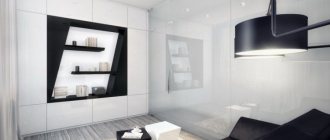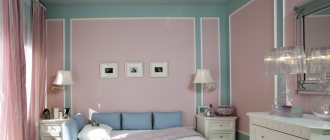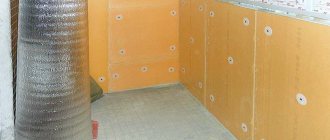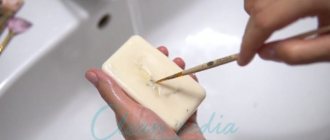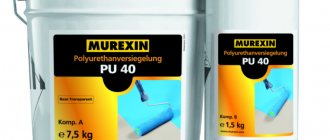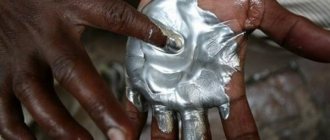Coloring compositions for cork coating
Paints and special compositions for cork surfaces are marked accordingly. Depending on the purpose, protective coatings and decorative ones differ. More information about painting cork floors can be found on the website https://domprobki.com.ua/articles/chem-krasit-probkovoe-pokrytie/.
As a rule, colorless compounds with certain properties (moisture protection, antifungal, insect repellent, fire retardant) are used as protective compounds.
How to paint?
To use the paint and varnish substance, you will need to prepare the surface of the cork cloth in advance. Preliminary measures include cleaning the surface from dust and dirt, sometimes using a primer mixture for better adhesion.
Cloths made from cork materials have different structures, operating conditions and performance parameters.
To understand. Before painting a cork, you must first decide on the purpose of the surface, and also evaluate the conditions of use.
For wall and decorative paintings, you can use any suitable composition; in the case of floor surfaces, you should choose the appropriate substances.
Cork surfaces in the interior of premises
Based on the high cost of cork fabric and its unique ornament and texture pattern, it would be pointless to paint this design idea. Therefore, it is worth paying attention to protective and varnish compounds for colorless corks.
Varnishing the cork will only emphasize its grace and originality, make it easier to care for the product and add gloss and elegance.
Coating with fire-resistant protection is important for decorative elements of kitchen premises, or in order to improve fire safety in general.
Varnish selection
The market for modern paint and varnish products offers a wide selection of materials for various needs. There are universal compositions that can be easily used for processing materials of different quality. Many products are offered for a certain type of decorative coating.
Polyurethane varnish is available for adhesive- and vinyl-based cork flooring. Its primary task is to enhance the moisture-resistant qualities of the coating. The applied substance penetrates deep into the base, filling, but not burdening its porous structure. After drying, an elastic, waterproof film is formed, strong and durable.
Polyurethane mixtures can be one- or two-component in chemical composition. The latter, due to the presence of hardeners, dry on the cork surface much faster (literally in two hours). For greater reliability, it is recommended to cover the floor with several layers of varnish.
After complete drying, the cork will acquire complete tightness, perfect evenness and absolute inertness to moisture, temperature changes and other “vicissitudes of fate.”
When choosing a varnish based on its composition, you should pay attention to the type of solvent. So, for indoor use you need a water-based parquet varnish. It is non-toxic and non-flammable. Also:
- has high final strength and elasticity;
- provides a high level of wear resistance of surfaces to chemicals;
- not afraid of low temperatures;
- does not slip;
- resistant to abrasion and strong mechanical loads;
- inertness to ultraviolet radiation allows you to varnish colored cork without fear of paint fading.
How to paint cork
Various variations of cork coverings are increasingly used in interior design of residential and commercial premises. This can be a base for laminate or parquet, a full-fledged finishing floor, wall slabs as an alternative to wallpaper and plaster. The main advantage of the material in any of these cases is its naturalness, the absence of polymer impurities, and despite this, excellent performance characteristics. Plus, finished finishing boards or panels have an amazing texture. That is why most owners of such coatings act on the “set it and forget it” principle, enjoying its natural beauty. But, there are situations when, for objective and subjective reasons, it becomes necessary to paint the cork. Let’s try to understand further the controversial aspects of the process, causes and consequences, as well as the necessary materials to carry out this task.
What do you have to deal with?
The use of any paint, regardless of type, has two main goals:
Decorative. Changing the color, shade of the surface to suit certain design ideas or create a more attractive appearance;
Protective. Creation of a barrier film on the surface that prevents contact of the main layer of material with external aggressive irritants.
In turn, the treated surfaces have different characteristics, structure, and operating conditions. This definitely affects the selection of paints, since what is suitable for metal is absolutely not suitable for wood. First of all, you need to understand how the cork works, what properties it differs in and how it behaves.
So, any of the available cork coverings (underlayment, floor/wall panels, interlocking floors) basically contains agglomerate. Simply put, it is the bark of the oak tree of the same name, crushed to a fraction of crumbs, which is mixed with natural binding components (resins) and pressed into slabs of different thicknesses. If you examine the finished product under a microscope, you can see the following picture.
Application
Where is cork used? It is used for finishing various rooms. Due to its ability not to absorb odors and liquids, it is used to line the walls in the kitchen. If you decorate a loggia or balcony with this material, then during the summer heat it will be about 7 degrees colder here compared to the street. In winter, the temperature will be the same amount higher.
Cork is widely used by designers when creating a wide variety of interiors. This material is often used as a wall covering due to the rich range of textures of finished products, colors and textures.
Cork is also used for finishing and decorating ceilings. In this case, the echo disappears in the room and the noise that can reach the next room decreases. It is cork coverings of walls and ceilings that can be found in many recording studios, as well as in cinemas. When arranging cork wall and floor coverings in a children's room, the noise from running around and playing is significantly reduced.
Different views on the issue
Anyone who, despite the relatively high cost of cork, still decides to use it for interior decoration, does so based on environmental friendliness, performance characteristics and the unique natural pattern of the material. It is this social and design traditionalism that largely determines the fact that it is not customary to paint such coatings. The maximum (and necessary) is a protective varnish treatment that emphasizes the texture.
In order to understand all the conservatism, just look at any specialized thematic forum and “Is it possible to paint cork?” In general, the entire subsequent information message will be reduced to the following formulation: “Why do this at all, how can you think of such a thing, because the paint hides the natural texture, which is why you bought the cork.”
This situation arises because this audience, for the most part, has not tried to paint such a coating. But this does not objectively mean that it is impossible or impossible to do this. Moreover, there are several objective reasons when painting is unavoidable or justified:
The color or shade of the cork does not match the desired color scheme of the room;
There is a desire to decorate certain areas of the floor or wall panels, for example, with a pattern;
The presence of defects from use on the surface, which cannot be eliminated by replacing the damaged section of the masonry without the ability, skills or desire.
How and with what to paint?
Since there are virtually no restrictions for painting cork, except mental ones, you can safely get to work. The first step is to choose the right main consumables. Obviously, from the entire list of paint and varnish mixtures available on the market, you need to focus on those that are created for processing wood. These can be either water-dispersed or water-based paints, or acrylic paints. As in the case of cork, you should not skimp on them, since this will ultimately affect the mechanical integrity and visual and decorative qualities of the coating.
Alternatively, you can use various stains, impregnations and oils. A common feature of all these materials is the ability to penetrate into the pores of the cork, creating a reliable protective barrier. At the same time, the coating does not at all interfere with air circulation inside the slabs, which means that the risk of rotting or the development of pathogenic microflora is eliminated. In addition, such impregnations tend to expand with temperature changes along with the wood, which will allow it to maintain its appearance for up to 8-12 years.
There is also a separate group of oils with various additives, for example, hard wax. The uniqueness of this group of paint and varnish products lies in the fact that the cork treated with them acquires additional strength, wear resistance, and water-repellent properties. These materials are also made on the basis of natural ingredients (linseed, sunflower, soybean and other oils), that is, they are environmentally friendly and safe. If you add a suitable pigment paste to the mixture during the dyeing process, you can radically change the shade or even color.
It is better to entrust all work to specialists, although, if you have certain skills, this task will not cause any particular difficulties. Naturally, you will first have to completely clean the surface of the cork coating from the base layers of varnish, thoroughly polish it and clean it from dust. Next, in accordance with the manufacturer’s recommendations, 2-3 layers of paint, stain, and oil are applied. Each subsequent layer is applied only after the previous one has dried. The final stage will require treatment with clear varnish. If oils were used, then after they dry, it will be enough to simply polish the cork.
Installation
Surface preparation
Before you lay down the cork flooring, the base will need to be prepared. Naturally, it should be dry and even. It is advisable to pour a concrete screed or a layer of self-leveling mixture.
Substrate requirements: evenness, dryness, absence of cracks and crevices
Before laying the logs, if you are making cork floors from scratch, it is advisable to treat all wood elements with a special antiseptic impregnation. If there is already a rough foundation, it needs to be carefully inspected. If there are cracks, crevices, or poorly secured elements, then all these shortcomings must be eliminated. Next, you can begin laying the cork.
How is the lock plug installed?
So, the base is prepared, you can install the cork floor. The entire process involves the following actions:
- Calculation of the amount of material required. To find out how many boards you will need, you need to determine the area of the room being processed. All technological gaps should also be taken into account, as well as the need for cutting the material.
- Installation of the substrate. It ensures maximum leveling of small uneven surface surfaces. As a substrate, you can use pressed cellulose, technical cork or foamed polyethylene. If the rough base is covered with plywood or chipboard sheets, then it must additionally be covered with plastic film.
- Installation of the plug on the floor. The board is laid in longitudinal rows. We must not forget about the technological distance from the walls. It is necessary because cork flooring tends to expand under the influence of temperature changes and moisture. If a gap is not left, the flooring may warp or heave. During installation, it is necessary to move the transverse seams.
Features of installing the adhesive plug
If your cork flooring is installed using glue, then the technology for carrying out the work is slightly different:
- Leveling the surface. To do this, you can use a cement mixture or self-leveling mortar. Before laying the board, you need to thoroughly vacuum the base. Otherwise, the adhesion of the subfloor to the cork will be poor.
- If the base is concrete, then it must be coated with a primer.
- Marking the base. Thanks to this procedure, you will be able to calculate how many boards you will need, and will also facilitate the installation process itself. Lay out the tiles according to texture and shade. Please note that if the walls are curved, then it is better to choose a diagonal type of installation.
- Fixing the material. The cork flooring can now be glued. You need to start this process from the corner opposite the door. That is, the board or tile must be fixed so that there are no flaws or defects in a visible place. The material must be glued using a special glue. It is applied to both the base and the cork. Next, you need to press the tile tightly to the subfloor and tap it with a rubber hammer. Please note that cork flooring in the bathroom or other rooms is fixed using a very viscous compound. Therefore, installation must be done as accurately as possible. Otherwise, you simply will not be able to tear off the incorrectly glued material or you will break it when you try to move it.
- If you need to trim the coating near walls, pipes or doorways, you can use a utility knife for this.
As you can see, a cork floor in a bathroom or other room will look very beautiful and will last quite a long time. The only thing is that you can’t use cork that is glued to MDF in wet rooms, i.e. cork laminate. Leave comments on the article!
Cork: how to paint it
In the field of interior design, much attention is paid to natural and environmentally friendly materials.
Natural cork, which is widely used for cladding walls and floors, can also emphasize natural motifs. This material is unique in its strength, durability, practicality, and is easy to care for. Cork is a good antistatic agent, and it also has heat and sound insulation properties. In order for the decorative coating to last longer, it is necessary to use a special varnish. In order for a decorative coating, especially a floor covering, to last longer, it is necessary to protect it.
Types of cork coverings
Surfaces in an apartment can be insulated and protected from sound with different types of cork coverings, which are available in the following forms:
- Wallpaper.
- Panels or tiles.
- Rolls.
- Liquid coating.
- Technical jam.
They are based on paper, which makes the coating thin, no more than 1 mm thick, convenient to use, thanks to this there is no need to make a backing for cork wallpaper. Wallpaper is used to cover the walls. They are glued using regular glue. Cork wallpaper must be glued end-to-end; the service life is about 10 years. Available in the form of a continuous sheet, rolls, or self-adhesive material.
Panels or tiles
Their dimensions can be 600 by 600 or 300 by 300, with a thickness of 3 mm. Panels or tiles are made from granulated cork under high pressure, pressure and temperature. The tile may contain various inclusions and be colored.
The panels have excellent properties and sound insulation characteristics and last from 10 to 30 years. The use of such material in an apartment will not only get rid of noise, but also keep the room warm in the winter, or cool the apartment in the summer.
This type of cork is produced in the form of a solid two-millimeter layer, which has a width of 500 mm. The bottom of the rolls is made of granulated cork, which is processed under pressure, and the top is made of cork veneer. The cork rolls that cover the walls are treated with wax on top. Rolls are used as a substrate for laminate, wood, stone or ceramic surfaces.
The composition is cork chips, which are bound with an acrylic substance. The liquid cork coating must be applied to the walls with a spatula or using a special sprayer.
This type of coating is characterized by the following properties:
- Soundproofs and insulates the room.
- Suitable for cladding facades, walls outside and inside, ceilings.
- It is used to insulate attics and basements, to create a waterproofing system on roofs and terraces.
- Suitable for creating warm floors.
Suitable for leveling the surface of walls, ceilings and floors. It has high heat, noise and sound insulation properties. It is produced in sheets that look like chipboard, rolls, and in the form of acoustic matting. Technical cork does not have a top layer of veneer, so prices for the material are lower than for liquid cork coating. There is also no wax or varnish coating on the technical cork. It is mainly used to insulate walls, replace carpet, linoleum.
How to paint cork floors
Cork is durable. It is clear that over time the owners will want to renovate the house, but for this it is not necessary to dismantle the cork floor if it does not fit into the overall style of the interior design. It can be painted, varnished, and its performance properties can be improved by using special impregnation compounds.
If you are thinking about the question of how to paint cork, the answer can be found on specialized websites. It is worth noting that painting cork is quite difficult. If you simply apply paint over the coating, you can only cause harm, since the paint will not last long and will also clog the pores, causing the floor to lose its properties.
The best option would be complex processing of the material:
- thorough cleaning of the slabs from the original layers of varnish and paint;
- grinding;
- dust removal;
- applying primer, paint, stain in several layers;
- At the last stage, a transparent varnish is applied.
To lighten the coating a little, if you are generally satisfied with the color, you can simply use transparent emulsion paints or colorless varnish. They also use the method of applying natural oil, to which a paste with the desired pigment is added. If you adhere to the technology, then after painting the coating will look like new. Experts also recommend not starting work on your own if you are not sure of the end result.
Cork floor care
Cork does not tolerate both high and low humidity. In winter, it is advisable to use humidifiers in the room. If you accidentally spill liquid, wipe it up immediately. You can wash the floor using detergents without aggressive ingredients. In this case, the rag should not be too wet, but only slightly damp.
Make sure that there are soft felt pads on the legs of the furniture, otherwise the cork will begin to fall around the legs. Applying polyurethane-based varnish is also an important maintenance step. From time to time the floor needs to be sanded and re-varnished. You can find special cork care products on sale. They need to be evenly distributed over the floor surface and wait until completely dry.
DIY wall decoration from cork material
If you decide to glue cork to the wall, you first need to prepare the wall. And also prepare the cork covering, buy glue and tools.
Surface preparation: essential features
You need to clean off dust and dirt from the walls, level them, and apply a primer. The primer strengthens the base and prevents the formation of bacteria. Afterwards you should wait for the primer to dry completely. For leveling, you cannot use gypsum-based compounds, as they can ruin the finishing material. When working, you need to remember that the air humidity level should not be higher than 65%, and the air temperature should be 18°. Wall humidity up to 3%.
Fastening sheets with a screwdriver
It is best to attach cork panels with a screwdriver. In this case, special clamps or brackets are used.
How to glue wallpaper
Materials and tools:
- Old fabric.
- Pencil or marker.
- Construction plumb.
- Scissors and a knife designed for cutting drywall.
- Small spatula.
- Comb for applying glue.
- Wooden or metal ruler.
The base must be completely dry, since the glue does not stick the material to a wet wall. The work must be done when the air humidity in the room is 40-60%, because wallpaper cannot withstand too dry air.
- You can check the humidity with a hygrometer. Next, measure the walls.
- Use a building level and a pencil to mark a vertical line on the wall.
- Mark the wallpaper and cut it to the required length with a very sharp construction knife, since the cork material is very brittle.
- If acrylic glue is applied to the wallpaper with a plastic spatula, then the wallpaper must be glued immediately. If it is contact glue, then first soak the wallpaper with glue for 5-10 minutes, and then glue it.
- Since glue cannot be removed from the front side of the wallpaper, do not allow it to get there.
- Cork wallpaper is glued horizontally or vertically.
- Various cutouts, for example, for sockets, should be made according to a template, that is, according to the socket box.
- In corners, cork wallpaper is not folded; it is applied to the corner, joined and cut off. If the cork wallpaper is already covered with wax, but dirty marks are visible on it, then you need to warm up this place with a hairdryer, then the wax will become soft and the marks will disappear.
Cork floor painting options
The top layer of cork is made from solid cork veneer.
It can also be pressed cork chips or a combination of veneer and agglomerate. In any variation, cork flooring looks impressive and beautiful. Designers offer interesting options for how to paint cork to make it sparkle with new interesting colors. As a rule, the cork is simply varnished, then it retains its appearance and texture, but becomes more durable.
If you paint the cork with paint, the material will be unrecognizable. So is it possible to paint cork, and in what situations should it be done?
Types of cork floors
Before deciding whether to paint the floor from the material described or leave it as it is, natural and natural, you need to understand the main types of coating.
Cork floors are:
- Floating floors. The material is a short board up to 13 mm thick, consisting of several layers. Usually this is four layers and this coating is laid according to the principle of parquet. If you put it in the kitchen, you need to cover it with several layers of protective varnish so that moisture does not spoil the floor over time.
- Adhesive floors are no more than 6 mm thick. If you find an adhesive plug that is less thick, this means that it is intended for walls and is not suitable for floors. The types of tiles in such a situation may be different. The advantage of this type of cork is that it is not afraid of moisture. These floors take longer to install and are more expensive than floating floors in total cost.
Types of cork wall coverings, scope of application
Cork is a natural material with an interesting texture. The production of such coatings is complex; there are many tiny air bubbles in the structure. Currently, this material is used for finishing walls in premises for various purposes, for example:
- kitchens;
- bathroom;
- children's;
- hallway;
- loggia.
Important! Cork has been used in the interiors of famous projects, for example, the rooms of the National Library of New York and the office of the largest corporation Volvo are decorated with it. Due to its excellent sound insulation, the material is also often used for recording studios.
The color palette of cork coverings includes the entire spectrum from light yellow to dark brown. The modern production process allows us to obtain textures with inclusions of blue, green, red, white strokes and spots, enriching interior compositions. Coatings are manufactured in the form of:
- Wallpaper.
- Rolls.
- Tiles.
Cork covering - tiles
During the production of cork wallpaper, 1 mm of cork veneer is applied to a paper or other base. Rolls are a thin layer of material glued onto compressed crumbs 1.2-2 mm thick. Sold without finishing with varnish or wax. Cork slabs can be single-layer or double-layer, thickness 2-6 mm. They are often tinted with paint, with a protective layer applied, standard sizes are 30 x 30 cm or 30 x 60 cm.
Is it possible to paint cork flooring?
Among builders and designers, the question of whether cork can be painted is always the cornerstone. The main reason for the conflict is why paint a beautiful and natural natural material.
Builders believe that there is no need to paint cork with any paints; they just need to cover the floor with several layers of varnish to improve performance.
The designers claim that if the owners want it, they can safely paint the cork. Sometimes there are situations when the natural color of cork is simply not suitable for creating a unique and ideal room concept. In such a situation, you cannot do without painting the cork.
Read here how to prevent scratches on your floor.
Otherwise, the design project will be impossible to implement. But it is not recommended to paint cork yourself, because this material is very delicate. It is important to choose the right color palette so that painting is justified in the end.
Since fading often occurs over more than one year, people simply do not notice the faded areas. But when rearranging furniture, this area may become noticeable. In such a situation, painting is needed to level the surface and again obtain an ideal coating.
If you couldn’t even it out to a natural color, you can think about a completely different palette, atypical for cork.
Choosing cork wallpaper for rooms
Cork wallpaper for walls, the design of which looks great both in the hallway and in the corridor. In addition, these wallpapers are easy to wash, and therefore they will always look like new, and you will not ask the question: how to glue cork wallpaper, because they are glued in exactly the same way as the simplest paper ones. Not long ago a new product came out where the wallpaper already has a paper-based adhesive composition, and gluing it is a pleasure. Cork wallpaper is very beautiful and always pleasing to the eye; if it is in the hallway, it will certainly delight guests. The hallway or hall, as it were, forms the first impression of the entire house as a whole, and therefore this wallpaper is perfect for such a room. Cork wallpaper will resemble a forest and therefore the interior can be supplemented with details such as the likeness of an old tree or thematic paintings.
Cork wallpaper for walls would also be a good choice for the kitchen, as they not only look beautiful, but also have excellent characteristics, not absorbing odors, fats and oils. If stains appear on the walls, they can be washed off: fresh stains with just warm water, and those that have already hardened with a cleaning agent. Manufacturers usually list cleaning products on the packaging.
Walls decorated with cork wallpaper in the bathroom will look interesting and original; this material can replace “cold tiles” and tiles. At the same time, the wallpaper is resistant to fungi and mold, which can appear in a room with high humidity.
And, of course, a design with cork wallpaper for the walls will look great in the living room. They will help create an atmosphere of comfort and warmth, and make the interior unique. An added bonus when using cork wallpaper in the living room is that it improves the acoustics in the room, making the living room a great home theater. In addition, such wallpaper is suitable for zoning a room, if you make one zone for relaxation and another for receiving guests.
How to paint cork
How to paint cork and how best to do it should be decided only with a professional. Painting cork yourself will be difficult, because such processing is unnatural for this material.
Painting adhesive floors will be much easier than floating flooring options. They need to be sanded before painting, but do not need to be varnished. When you want to preserve the pleasant natural structure of the natural material being described, it is better to choose a transparent natural color.

